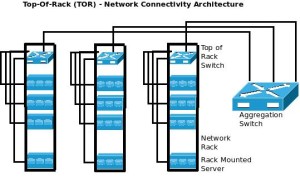Data center network design II

Here we are again!!
This week we have an extra post where we are going to continue our data center network design we started explaining the previous week.
In the previous post we focused on the devices we’ll be using to design our data center and now we’re going to talk about other important aspects it must be considered when designing any data center’s network.
First of all, it’s important to distinguish the LAN network from the SAN (Storage Area Network). In the previous post we focused on the LAN part, but now we’re going to introduce the SAN network, which will contain the devices that will store critical data of the bank.
For this part of the network, we’ll be using Fibre Channel (FC) which is the technology usually used in SAN environments as the communication protocol for provisioning of storage.
Brocade will still be our manufacturer for this storage network, but as we’ll be using Fibre Channel, we’ll have to look for devices that support this type of technology.
Other important aspects to consider are: redundancy, which topology apply, load balancing or network protocols for example.
Topology
We’ll be using switches with top-of-the-rack connections to facilitate manageability and have a cleaner environment.
Redundancy
As we are designing the network for a bank, data is critical and link failures cannot be considered so the problem must be treated. Despite the increasing number of cables, all switches must have redundant links because if there’s a link failure, another backup path can be taken.
Ideally, hardware and software should be redounded so all possible failures must be controlled, but that means a very expensive design so we must be clever and do a correct design to only redound the necessary.
In our case, and concerning to LAN and SAN devices, we’re only going to redound links.
Load balancing
As a user, anybody wants to have a slow response because your data has been traveling for a path that is collapsed, so to avoid network overloading we’ll also need devices to distribute traffic so all links can handle correctly the data.
We’ll use a device from Brocade ServerIrons family to solve this problem.
Network protocols
As a requirement we have that STP (Spanning Tree Protocol) must be avoided. This restriction is because in case of any link failure, this protocol needs more than 30 seconds to detect and recover the network and in a bank, as we’ve said thousands of times, data is critical, that much time can mean money losses.
We have different alternatives to STP, some of them are VSS (Virtual Switching System) or vPC (virtual Port Channel), but we can also find other technologies based on our manufacturer; TRILL (Transparent Interconnection of Lots of Links) for example.
Note: Despite the protocol used this part will be done by configuring the switch so it does not affect on the device chosen.
See you next week!!

Add new comment